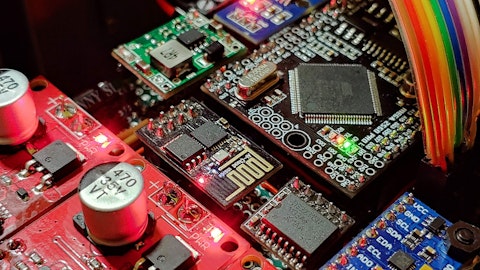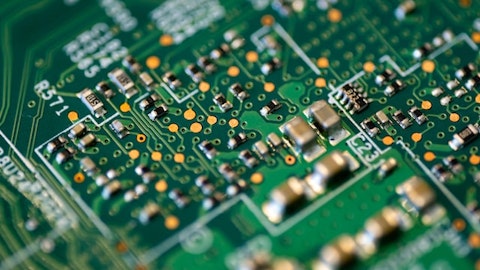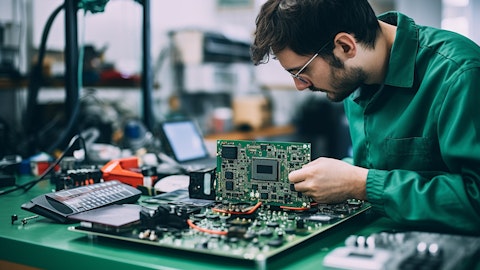Rob Mionis: Yeah. Good question. So our industrial business in ‘23, a way of reminder, grew close to 30%. Again, it was fueled by green energy programs, including EV charging, energy storage, energy generation. As we were exiting the year, demand started cycling down in some of these markets and the markets that were really impacted were interest rate sensitive markets, but moreover, because the material environment has dramatically improved, our customers were taking the opportunity to reduce their strategic inventory buffers. We think those buffers will normalize in the first half of the year, and in the second half of the year, we have new programs, ramps planned, which would return the industrial business to growth. And our capital equipment business, as I mentioned earlier, we’re cautiously optimistic as we get to the back half of the year and certainly into 2025 that we’re seeing some signs of growth and the costs are pretty much aligned there.
And again, we’re seeing some spares orders. And as a reminder, some of the headwinds that we’re seeing in ATS we think will be more than offset with our strength that we’re seeing in our CCS business.
Maxim Matushansky: Great. Thanks. I’ll pass the line.
Operator: Thank you. We have our next question coming from the line of Thanos Moschopoulos from BMO Capital Markets. Please go ahead.
Thanos Moschopoulos: Hi. Good morning. With respect to the full year guidance, I hear you with respect to wanting to discuss the second half outlook with your customers before revisiting the guidance. But certainly from the demand signals, you’re highlighting it seems like it’ll be a stronger second half. I guess from your perspective, what might be the key areas of uncertainty you want to further color on before visiting guidance? Would that be on semi and industrial, or which areas would be the biggest source of demand variability as you think about second half?
Mandeep Chawla: Yeah. Hi, Thanos. Mandeep here. So we were pleased to be able to interlock with our customer base, specifically on the hyperscaler side in the fourth quarter, and that has led us to confidently come out with the outlook that we did. Even after our virtual investor meeting in November, we saw incremental improvement to the forecast coming from the hyperscalers, and so that’s reflected in our Q1 guidance. Again, our outlook is for 14% year-over-year growth, which is higher than what we would have said probably in November. And we’re seeing that demand strength continue into the second quarter. So the conversations with the hyperscalers are, is there an improvement in material availability on your end? Is there — has your deployment change — plans changed at all?
And how does that impact the second half of the year? Is it going to be similar to what we’re seeing right now in the first half of the year? And then to Rob’s point on capital equipment. So our assumption right now is that the base market is going to be flat. We’re around trough levels right now, some encouraging signs as Rob talked about, and where we’re expecting the growth to be in capital equipment is as we ramp AS/ML. AS/ML is a customer of ours for a few years now, but we’ve won a number of programs over the last year or so, and those programs are in the process of being ramped right now, and the demand signals from that specific customer have not changed. And so what we’re looking to do as we go to the rest of the customer base in capital equipment is to understand whether or not some of these early signs that we’re seeing in terms of consumables and spares is going to lead to a demand uptick in the back end of the year.
And so it’s really around hyperscalers and capital equipment.
Thanos Moschopoulos: That’s helpful. And then on the softness in industrial, just to clarify, is that primarily lead edged in green energy or is that kind of across the board in your various end markets of an industrial?
Rob Mionis: I thought also its pronounced mostly in EV charging, which is kind of being driven by a slowdown in EV sales and also some of the incentives, at least in the U.S. are slow to get out to the marketplace, that’s having some impact as well as the higher interest rates. But we’re also seeing a little bit of a slowdown in, I’ll call it the broader industrial space, just driven by the burn down of strategic inventory buffers. Again, we expect some new program ramps and the burn down of the buffers for this entire industrial business to start resuming to grow from the back half of the year.
Thanos Moschopoulos: Great. [indiscernible]
Rob Mionis: Thanks.
Operator: Thank you. We have our next question coming from the line of Daniel Chan from TD Securities. Please go ahead.
Daniel Chan: Hi. Good morning. Congrats on a strong quarter here. So communications was stronger than expected this quarter, was that driven by AI demand strength or was that from non-AI related cloud demand where we’re also starting to see some early signs of recovery?
Rob Mionis: In terms of comms, it was driven by networking, which is kind of the pull through that we’ve been mentioning that we would see as a result of AI/ML demand. And within networking, there’s, I’ll call it, AI/ML networking, which is directly driven and we’ve seen both in those programs, networking comes in a couple different flavors. The 48 volt is really driven by some of the AI/ML applications and we’ve certainly seen an uptick in that.
Daniel Chan: And then, we’ve seen a lot of new data center leasing activity. So just curious on the timing of this communications ramp as you guys are expecting 800G to ramp into 2025. So with all these new data centers coming online, are these new builds going to have 800G in them or will they leverage 400G to begin with? So just wondering, like, with them building out all these new data centers this year, whether they’re going to be putting a lot of that next generation stuff or whether they’re going with current generation equipment.



